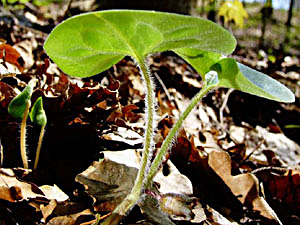
medicinal herbs
Asarabacca
Asarum europaeum

Herb: Asarabacca
Latin name: Asarum europaeum
Family: Aristolochiaceae (Birthwort Family)
Medicinal use of Asarabacca:
Asarabacca has a long history of herbal use dating back at least to the time of the ancient Greeks, though it is little used in modern herbalism. The root, leaves and stems are cathartic, diaphoretic, emetic, errhine, sternutatory, stimulant and tonic. The plant has a strong peppery taste and smell. It is used in the treatment of affections of the brain, eyes, throat and mouth. When taken as a snuff, it produces a copious flow of mucous. The root is harvested in the spring and dried for later use. Use with caution, see the notes above on toxicity. An essential oil in the root contains 50% asarone and is 65% more toxic than peppermint oil. This essential oil is the emetic and expectorant principle of the plant and is of value in the treatment of digestive tract lesions, silicosis, dry pharyngeal and laryngeal catarrh etc.Description of the plant:

Plant:
EvergreenPerennial

Height:
10 cm(4 inches)

Flowering:
May toAugust

Scent:
ScentedPerennial
Habitat of the herb:
Open woodland and waterside thickets, especially in beech woodlands.Other uses of Asarabacca:
A vibrant apple-green dye is obtained from plant. A useful ground cover for a shady position so long as it is not dry, spreading by its roots.Propagation of the herb:
Seed - best sown in a cold frame as soon as it is ripe in the summer. Stored seed will require 3 weeks cold stratification and should be sown in late winter. The seed usually germinates in the spring in 1 - 4 or more weeks at 18°C. When large enough to handle, prick the seedlings out into individual pots and grow them on in light shade in the greenhouse for at least their first winter. Plant them out when large enough in late spring. Division in spring or autumn. Plants are slow to increase. It is best to pot the divisions up and keep them in light shade in the greenhouse until they are growing away strongly.Cultivation of Asarabacca:
Open woodland and waterside thickets, especially in beech woodlands.Known hazards of Asarum europaeum:
The plant is poisonous in large doses, the toxin is neutralized by drying.Plant information taken from the Plants For A Future.
